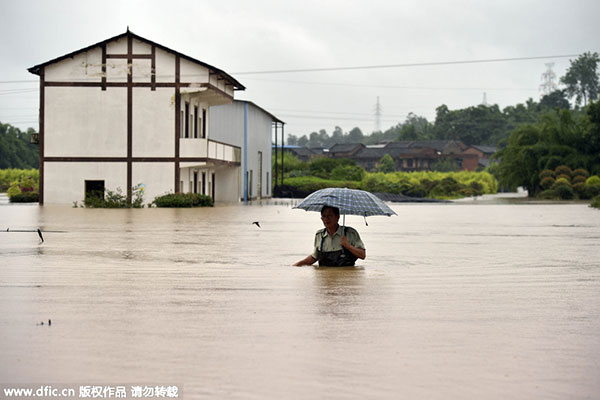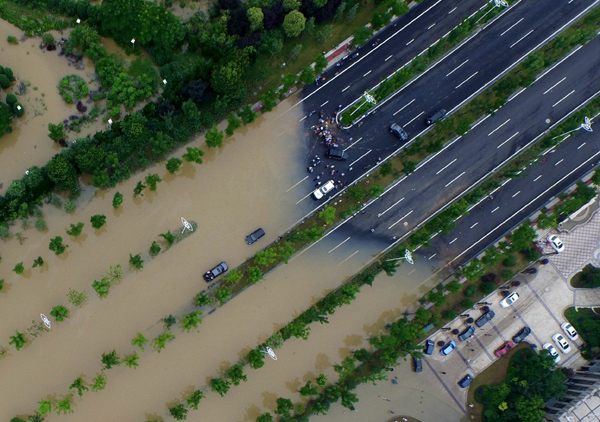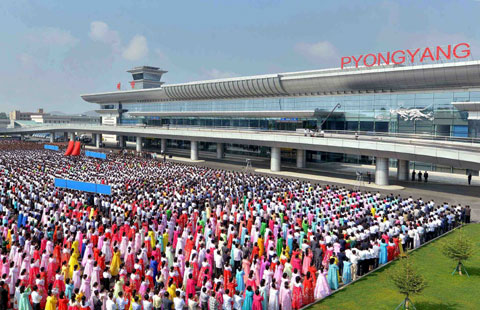'Rarest' South China floods leave 100 dead, cause $5.6b loss
Updated: 2015-07-02 11:51
(chinadaily.com.cn)
|
||||||||
 |
|
A villager holding an umbrella walks in flood caused by heavy rain in Chongqing, June30, 2015. [Photo/IC] More photos: East China floods disrupt life |
Floods are an annual occurrence in many cities across China, especially in the south during the summer.
Dubbed the "strongest and rarest" in terms of severity, continuous downpours, rain-triggered floods and landslides battering 20 provinces and regions across the country this year have caused direct economic loss of 35.3 billion yuan ($5.6 billion) and have left at least 108 people dead, claimed Economic Information Daily.
A total of 20.79 million people have been affected and more than one million forced to evacuate. The floodwater has also caused damage to about 1.7 million hectares of crops and 44,000 houses.
The prices of daily commodities, including vegetables and poultry, are expected to increase in the summer due to the damage caused to the farmlands and the rise in transportation cost.
The meteorological and agricultural experts said that El Nino phenomenon, a warming of sea-surface temperatures in the Pacific, was the cause of the severe weather.
They predicted that the phenomenon, which might last until autumn, is going to make "the floods in southern China and drought in the north" much worse than the previous year.
Experts suggested the construction of drainage systems, adding that it is an effective way to combat flood and drought in the future.
Related: 'Sponge City' program set to soak up urban floodwater
By Xu Wei (China Daily)
 |
|
A photograph taken from a drone shows Jiangjun Avenue in Nanjing, Jiangsu province, covered with water on Sunday after heavy rains. Urban areas of the city experience urban flooding every year. [WU JUN/CHINA DAILY] |
For residents of Shanghai, Nanjing and Wuhan, rainstorms often mean high levels of water, flooded roads ... and sometimes even an unexpected opportunity to fish in the streets.
On the night of June 16, torrential rain flooded Shanghai's northern districts, crippling the city's transportation network as vehicles stalled in floodwater and pedestrians were forced to roll up their pant legs and wade through the deluge.
Students at Tongji and Fudan universities, both located in Shanghai, managed to find a little fun when goldfish escaped from the flooded ornamental ponds on campus, and a fishing contest ensued as the students tried to catch and return the fish.
At Fudan University, students had no alternative but to trudge to classes through the high water and heavy rain, leading senior student Su Yiwei to lambaste the school, which she said should have responded to the conditions more effectively. "In such a scenario, the university should establish an emergency response plan and cancel classes in time," she said.
Yang Zhenghong, an official with the School Assets Department at Tongji University, said ongoing construction work near the university campus has reduced the efficiency of the college's drainage system.
"The base height of the roads around the campus has continued to rise along with the urban construction drive, especially the building of new rail transit lines. Our drainage system cannot cope in times of heavy rain," he told China Central Television.
In recent years, summer flood shave disrupted campuses at other schools, including universities in Wuhan, Nanjing and Xiamen.
Although they have dominated the headlines, Shanghai, Nanjing and Wuhan are just three of more than 100 cities across China that are disrupted by urban flooding every year, according to the State Flood Control and Drought Relief Headquarters. In 2012, urban flooding affected 184 cities, while in 2013 the number was 234, and last year it was 125, it said.
Zhang Jiatuan, a spokesman for the authority, said local governments have failed to pay sufficient attention to drainage systems, which has led to regular floods in a large number of cities.
"For a long time, local authorities have paid too much attention to 'above ground' construction projects, which are highly visible political achievements, and have ignored factors that aren't usually seen, including the drainage systems," he said.
Failure to meet standards
More than 300 of China's 657 cities fail to reach the national standards for flood prevention in urban areas, and more than 90 percent of older urban areas don't even meet the lowest criteria for flood prevention, according to Zhang. "Urban flooding will only get more serious if we continue to ignore the construction of drainage systems and sewers," he said.
Liu Bo, an official with the Office of Environmental Sanitation in Changde, Hunan province, who is one of the country's leading authorities on low-impact development, said many cities have to rely on pumping stations to drain storm water, mainly as a result of a poorly designed and maintained drainage systems.
"The urbanization drive, especially the construction of large areas of land with impervious surfaces, has made storm drainage virtually impossible. The storm water runoff stays on the surface and then converges into floods," he said.
Liu also said that local authorities have largely ignored the construction of drainage systems amid the urbanization drive, adding that urbanization and construction have resulted in huge areas being covered over with impervious materials, such as tarmac, which prevent excess water from draining into the soil.
- Mass casualties in Indonesian military plane crash
- Japan's LDP lawmaker denounces Abe's security policies
- More than 100 feared dead in Indonesian military plane crash
- More than 50 may die in Indonesian plane crash
- Japan's Diet gets 1.65m signatures against security bills
- Thailand's first MERS case declared free of deadly virus

 Western Europe swelters in long-lasting heat wave
Western Europe swelters in long-lasting heat wave
 Top 10 shareholders of AIIB
Top 10 shareholders of AIIB
 Massive Hello Kitty theme park opens to visitors
Massive Hello Kitty theme park opens to visitors
 New terminal of Pyongyang Intl Airport put into use
New terminal of Pyongyang Intl Airport put into use
 Ten paintings to remember Xu Beihong
Ten paintings to remember Xu Beihong
 Obama hails new chapter in US-Brazil relations
Obama hails new chapter in US-Brazil relations
 Boxers top Forbes highest paid celebrities list
Boxers top Forbes highest paid celebrities list
 Not so glamorous: Glastonbury ends with sea of rubbish
Not so glamorous: Glastonbury ends with sea of rubbish
Most Viewed
Editor's Picks

|

|

|

|

|

|
Today's Top News
Economic growth driving force for China's future mobility: Think tank
'Operation duck' and the student savior from internment camp
White House lifts ban on cameras during public tours
China, Canada seek to increase agricultural trade
A Canadian comes to Xi'an, finds personal, business success
Fewer Chinese seek US grad schools
US, Cuba to announce reopening of embassies on Wednesday
China bests MDGS for improved drinking water, sanitation
US Weekly

|

|






